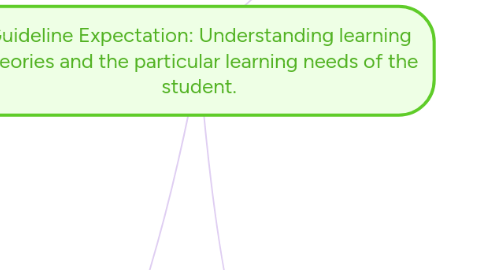
1. Student Learning
1.1. Individualized Education Plans
1.1.1. Student Needs
1.1.1.1. Physical Exceptionality
1.1.1.1.1. Ex. Blind-Low Vision
1.1.1.2. Behavioural Exceptionality
1.1.1.2.1. Ex. ADHD
1.1.1.3. Communication Exceptionality
1.1.1.3.1. Ex. Language Impairment
1.1.1.4. Intellectual Exceptionality
1.1.1.4.1. Developmental Disability
1.1.2. Assessment
1.1.2.1. Woodcock Reading Mastery
1.1.2.2. Keymath
1.1.2.3. Peabody Picture Vocabulary Test
1.1.2.4. Test of Language Development
1.1.2.5. Woodcock Johnson III
1.1.3. Diagnosis
1.1.3.1. Psychological Assessment
1.1.3.2. Physical Assessment
1.1.3.3. Behavioural Assessment
1.1.3.4. Reports from Doctors
1.2. Modifications
1.2.1. Mathematics Curriculum
1.2.2. Language Arts Curriculum
1.2.3. Science & Technology Curriculum
1.2.4. Health & Physical Education Curriculum
1.2.5. Social Studies Curriculum
1.2.6. The Arts Curriculum
1.3. Accomodations
1.3.1. Environmental
1.3.1.1. Classroom Lighting
1.3.1.2. Classroom Arrangement
1.3.1.3. Noise Level/Quiet Space
1.3.1.4. Providing Pencil and Pen Grips
1.3.1.5. Allowing Student to Stand/Lie Down etc
1.3.1.6. Access to Resource Rooms, ASD Rooms etc.
1.3.2. Instructional
1.3.2.1. Use of Assistive Technology
1.3.2.1.1. Voice Recorder
1.3.2.1.2. iPad
1.3.2.1.3. Computer
1.3.2.1.4. Audio Tapes
1.3.2.1.5. Manipulatives
1.3.2.1.6. Timers
1.3.2.2. Graphic Organizers
1.3.2.3. Enlarged Print & Magnifiers
1.3.2.4. Text in Braille
1.3.2.5. Breaking Instructions into Steps
1.3.2.6. Role Play
1.3.2.7. Modelling
1.3.2.8. Pair/Group Work
1.3.2.9. Mindmapping
1.3.2.10. Scribing
1.3.3. Assessment
1.3.3.1. Extra Time/ No Time Restraints
1.3.3.2. Any Environmental and Instructional Accomodations During an Assessment
2. Learning Theories
2.1. Piaget's Stages of Development
2.1.1. Parts of the Brain Develop at Different Times
2.1.1.1. Different Abilities/ Milestones occur at Different Times
2.1.1.1.1. Physical Milestones
2.1.1.1.2. Cognitive Milestones
2.1.2. Schemas
2.1.2.1. New Information can:
2.1.2.1.1. Fit into Pre-existing Schemas (Assimilation
2.1.2.1.2. Change/ Pre-existing Schemas (Accomodation)
2.1.2.1.3. Cause Equilibration
2.2. Vygotsky's Sociocultural Theory
2.2.1. Scaffolding
2.2.2. Zone of Proximal Development
2.2.3. Learning through Social Interactions
2.2.3.1. In the Classroom
2.2.3.1.1. Teacher
2.2.3.1.2. Peers
2.2.3.2. At Home
2.2.3.2.1. Parents/Guardians
2.2.3.2.2. Siblings
2.2.3.2.3. Friends
2.2.3.2.4. Extended Family
2.3. Skinner's Operant Conditioning
2.3.1. Behaviours are Reinforced by Rewards
2.3.1.1. More Likely to Occur in Future
2.3.2. Behaviours are Discouraged through Punishment
2.3.2.1. Less Likely to Occur in Future
2.4. Bandura's Social Learning Theory
2.4.1. Learning through Observation
2.4.1.1. Activation of Mirror Neurons in Brain
2.4.1.1.1. In-Direct Reinforcement of Behaviours
2.4.1.1.2. In-Direct Punishment for Behaviours
